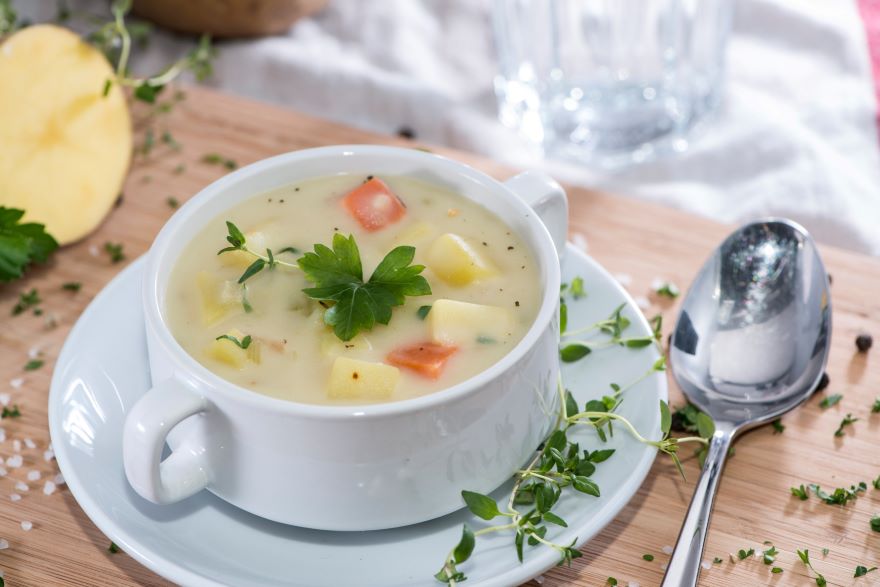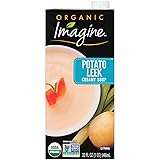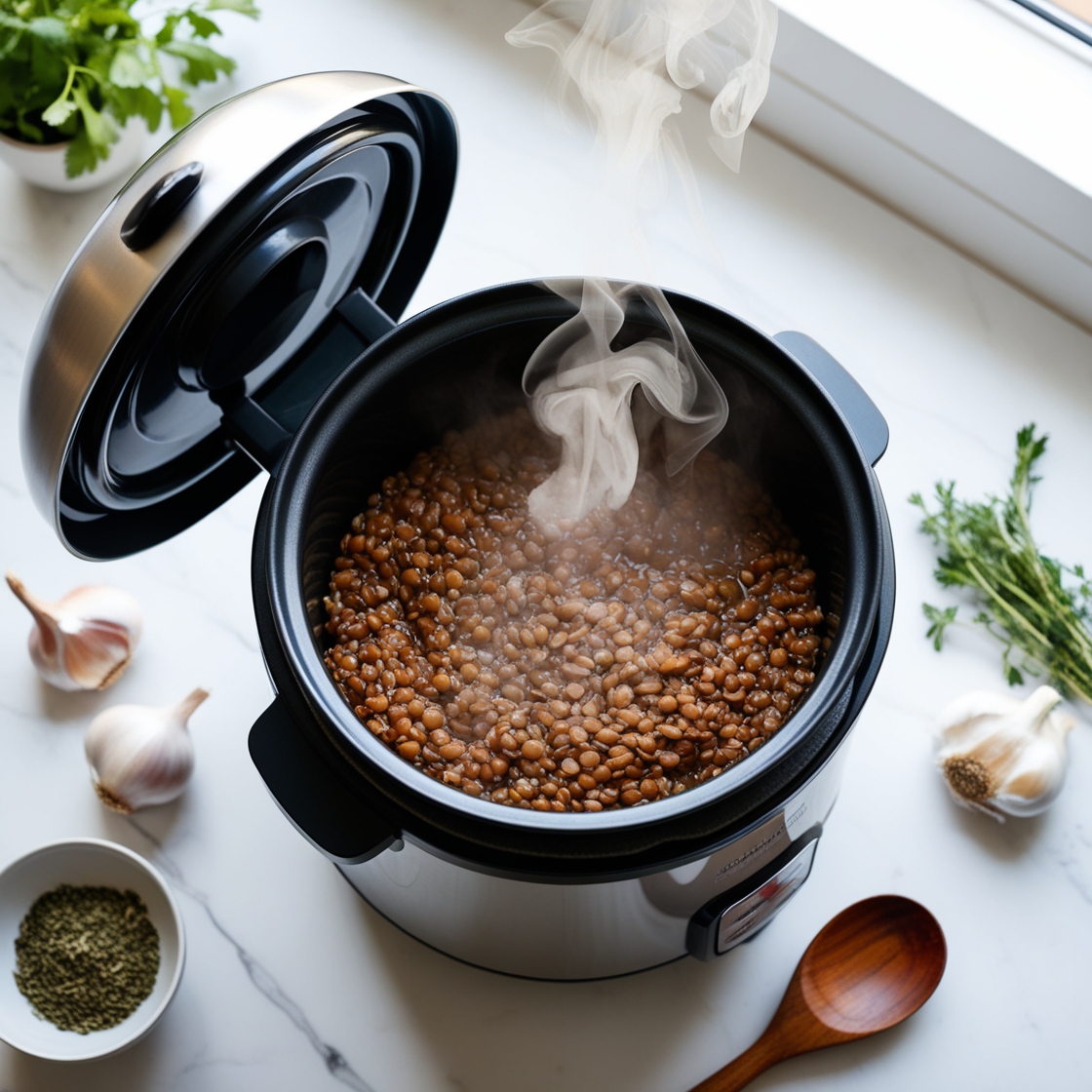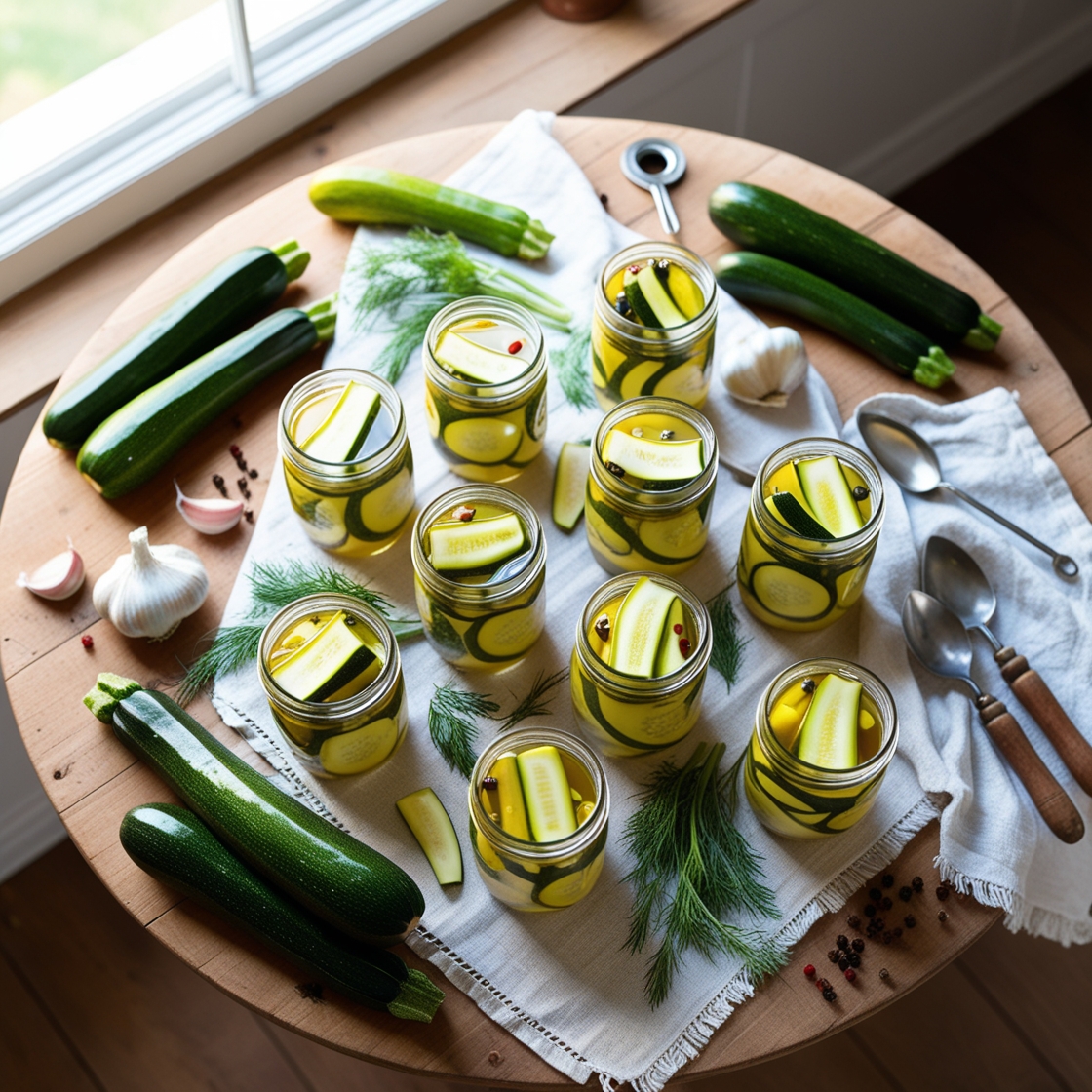When winter winds howl outside, nothing warms the body and soul quite like a steaming bowl of homemade soup. In our home, potato soup has become a cherished tradition. This dairy-free potato soup has emerged as a favorite—proving that comfort food can be both delicious and inclusive.
Many of us have our own versions of potato soup, often featuring cream, butter, or cheese. This recipe offers all the creamy comfort without any dairy products. Whether you’re lactose intolerant, vegan, or simply reducing dairy consumption, this soup maintains the richness of traditional recipes through plant-based alternatives.
What makes this soup special is how it harnesses the natural flavors of fresh ingredients while maintaining nutritional balance. After many kitchen experiments, I’ve learned that with the right substitutes—vegetable broth, plant-based milks, and natural thickeners—we can create a velvety texture that rivals conventional recipes.

Exploring Dairy-Free Alternatives
When it comes to soup, the creamy texture is often achieved with dairy products like milk and cream. However, for individuals with lactose intolerance, consuming milk can lead to discomfort or digestive issues.
Dairy Alternative Comparison
Different non-dairy milks bring unique characteristics to your potato soup:
| Dairy Alternative | Flavor Profile | Texture Effect | Nutritional Highlights | Best For |
| Almond Milk | Light, nutty | Thin, light | Low calorie (30-40 cal/cup), vitamin E | Lighter soups |
| Coconut Milk | Tropical, sweet | Rich, creamy | Higher fat content, MCTs | Ultra-creamy soups |
| Oat Milk | Mild, slightly sweet | Creamy, silky | Fiber-rich, beta-glucans | All-purpose option |
| Cashew Milk/Cream | Subtle, buttery | Very creamy | Heart-healthy fats, copper, magnesium | Richest texture |
| Soy Milk | Neutral, beany | Medium body | Complete protein (7-8g/cup) | Protein-boosted soups |
Essential Ingredients for a Perfect Dairy-Free Potato Soup
Making a perfect dairy-free potato soup depends on a well-curated selection of ingredients. Focus on choosing optimal potatoes for texture, leveraging aromatic vegetables and herbs for depth of flavor, and incorporating the right thickening agents to achieve a creamy consistency without dairy.
Selecting the Right Potatoes
For the base, choosing the right type of potato is essential:
- Russet potatoes: Ideal for their starchy quality, which lends a creamy texture upon blending
- Yukon Gold potatoes: Offer a naturally buttery flavor that complements the dairy-free aspect of the soup
- Red potatoes: Hold their shape better for soups with more texture and chunks
Aromatic Vegetables and Herbs
The soup’s flavor foundation relies on aromatic vegetables and herbs:
- Onions and garlic: Sauté to develop sweetness and savoriness
- Carrots and celery: Add complexity and subtle earthy notes
- Herbs: Green onions, thyme, rosemary, and bay leaves add depth
- Seasonings: Salt, pepper, and other complementary spices like paprika or nutmeg
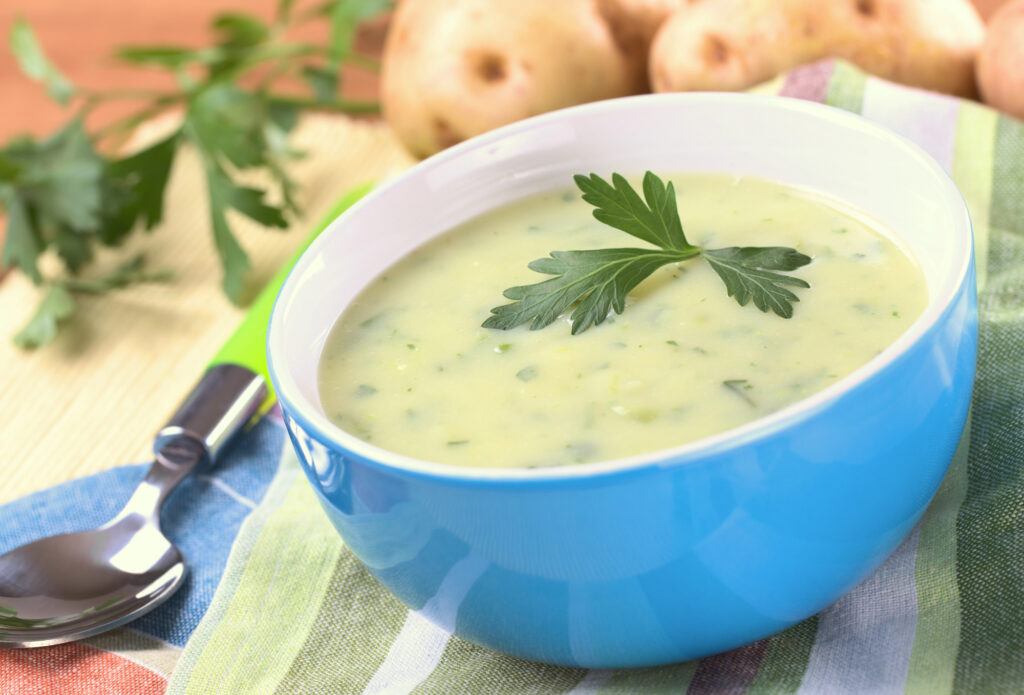
Thickening Agents
Without dairy, achieving a hearty thickness relies on alternative thickening agents:
- Flour-based roux: Made with plant-based butter or oil
- Puréed vegetables: Blend part of the soup to thicken naturally with potato starches
- White beans: Add thickness and boost protein content
- Coconut cream: The solid portion separated from canned coconut milk
- Nutritional yeast: Adds a cheesy flavor while slightly thickening
By carefully balancing these essential ingredients, every bowl of dairy-free potato soup can be wholesome, rich, and indulgently creamy.
Complete Recipe: Classic Dairy-Free Potato Soup
This recipe serves as an excellent foundation that you can customize based on your preferences.
Ingredients (Serves 6):
- 2 lbs (about 6 medium) Russet potatoes, peeled and diced
- 1 medium yellow onion, diced
- 3 cloves garlic, minced
- 2 medium carrots, diced
- 2 stalks celery, diced
- 2 tbsp olive oil or plant-based butter
- 2 tbsp all-purpose flour (or gluten-free alternative)
- 4 cups low-sodium vegetable broth
- 1 cup unsweetened oat milk
- 1/2 cup full-fat coconut milk
- 1 tsp dried thyme
- 1/2 tsp dried rosemary
- 1 bay leaf
- 2 tbsp nutritional yeast (optional, for cheesy flavor)
- Salt and pepper to taste
- 3 green onions, thinly sliced (for garnish)
- Plant-based bacon bits (optional, for garnish)
Instructions:
- In a large pot or Dutch oven, heat olive oil over medium heat. Add onions and sauté for 3-4 minutes until translucent.
- Add garlic and cook for an additional 30 seconds until fragrant.
- Add carrots and celery, cooking for 5 minutes until they begin to soften.
- Sprinkle flour over the vegetables and stir continuously for 1-2 minutes to create a roux.
- Gradually add vegetable broth while stirring to prevent lumps from forming.
- Add diced potatoes, thyme, rosemary, and bay leaf. Bring to a boil, then reduce heat and simmer for 15-20 minutes until potatoes are fork-tender.
- Remove the bay leaf. Transfer approximately half of the soup to a blender and blend until smooth, or use an immersion blender directly in the pot to partially blend the soup, leaving some chunks for texture.
- Return the blended soup to the pot if using a countertop blender.
- Add oat milk, coconut milk, and nutritional yeast (if using). Stir well and heat gently without boiling.
- Season with salt and pepper to taste.
- Serve hot, garnished with sliced green onions and plant-based bacon bits if desired.
Cooking Techniques and Tips
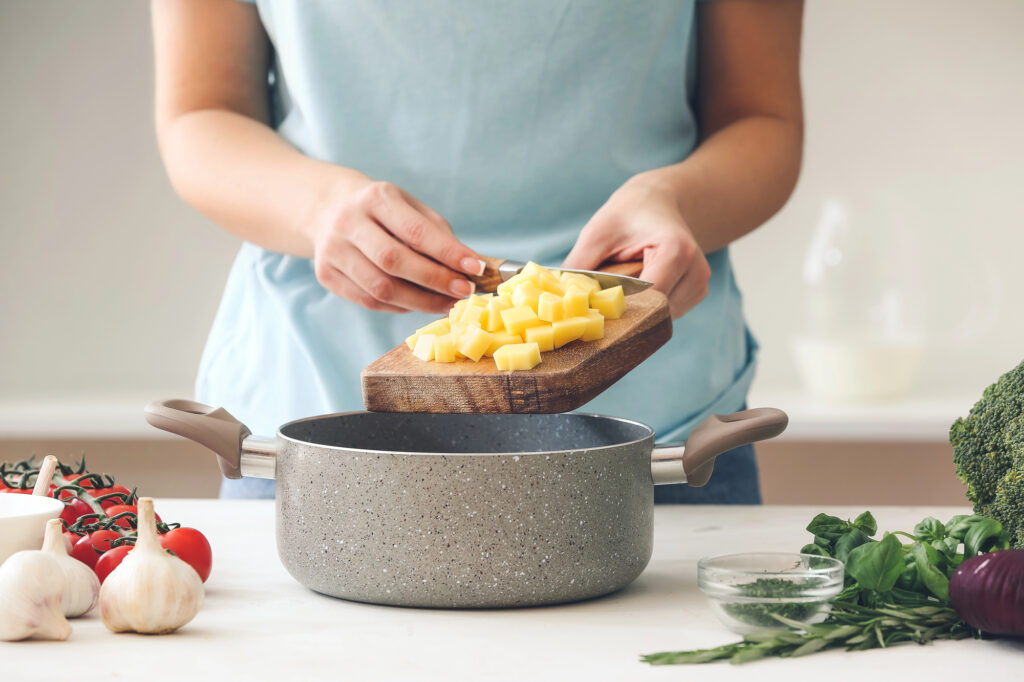
Attention to preparation, blending, and seasoning is key to a sumptuous soup.
Preparation Steps
For a smooth soup-making process:
- Wash, peel, and dice potatoes into even sizes to ensure uniform cooking
- Sauté aromatics before adding liquids to develop deeper flavors
- Reserve a cup of diced potatoes to add after blending for texture
- Prepare all ingredients in advance (mise en place) for efficient cooking
Equipment Recommendations
The right tools make a significant difference in your soup outcome:
Heavy-bottomed pot or Dutch oven: Provides even heat distribution and prevents burning
Immersion blender: Allows for easy blending directly in the pot with better control over texture
High-powered blender: Creates ultra-smooth textures when desired
Fine mesh strainer: Useful for straining the soup for the silkiest possible texture
Wooden spoons: Gentle on cookware and excellent for stirring thick soups
Ladle: Provides clean serving without drips or spills
If you want to elevate your soup-making experience, the Le Creuset Enameled Cast Iron Dutch Oven is the perfect tool. Known for its exceptional heat retention and even cooking, this Dutch oven will allow you to cook your dairy-free potato soup with ease, bringing out the flavors and ensuring the perfect consistency. Its enameled surface means no need for seasoning, and it can go from stovetop to oven, offering versatility in your cooking. Plus, the vibrant color options add a touch of elegance to any kitchen.

Le Creuset Enameled Cast Iron Signature Oval Dutch Oven, 8 qt., Caribbean
- Enameled cast iron delivers superior heat distribution and retention; Ready to use, requires no seasoning
- Easy-to-clean and durable enamel resists dulling, staining, chipping and cracking
- Light colored smooth interior enamel allows easy monitoring of cooking progress
- Tight-fitting lids are specially designed to circulate steam and return moisture back to the food; Ergonomic knobs and wide loop handles are designed for easy lifting
Blending for Creaminess
Once the potatoes are tender:
- For a partially chunky soup, remove some potato pieces before blending
- If using an immersion blender, pulse gently to control texture
- If using a standard blender, work in batches filling only halfway
- Allow steam to escape when blending hot liquids to prevent pressure buildup
- For ultra-smooth texture, blend longer and consider straining afterward
For anyone serious about creating the smoothest, creamiest dairy-free soups, the Vitamix 7500 Blender is a game changer. This high-performance blender can effortlessly blend all your ingredients, from potatoes to plant-based milks, into the velvety texture you desire. Whether you’re making this dairy-free potato soup or any other creamy creation, the Vitamix 7500’s powerful motor and precision controls ensure that your soups will come out perfectly every time. The low-profile design is perfect for any kitchen, and it’s durable enough to handle heavy daily use.

Vitamix Professional Series 750 Blender, Professional-Grade, 64 oz. Low-Profile Container, Black, Self-Cleaning – 1957
- Automated Blending: Five pre-programmed settings ensure simple cleaning, walk-away convenience, and consistent results for smoothie, frozen dessert, soup, and purée recipes.
- You’re in Control: Variable Speed Control and Pulse feature let you manually fine-tune the texture of any recipe;Cord: 6 ft
- Low-Profile 64-ounce Container: Perfect for family meals and entertaining, while fitting comfortably under most kitchen cabinets. Electrical Ratings – 120 V, 50-60 Hz, 12 Amps
- Hardened Stainless-Steel Blades: Our aircraft-grade stainless steel blades are designed to handle the toughest ingredients, so from the first blend to the last, you get the same quality results.
Seasoning and Simmering
- Season in stages – add basic seasonings early and adjust at the end
- Simmer for about 20 minutes after blending to meld flavors
- Add any reserved potato pieces during this final simmer
- Taste and adjust seasonings right before serving
- Total cooking time should be under an hour for efficiency

Enhancing Flavor and Nutrition
Achieving a delicious taste while maintaining nutritional balance requires thoughtfully chosen ingredients and creative toppings.
Balancing Macronutrients
To ensure the soup is both satisfying and health-conscious:
- Protein: Add lentils, chickpeas, or white beans to boost protein content
- Healthy Fats: Use olive oil or plant-based butter for richness
- Complex Carbohydrates: Sweet potatoes or whole grain additions for fiber
- Micronutrients: Colorful vegetables increase vitamin and mineral content
- Sodium Control: Use low-sodium broth and adjust seasoning to taste
Adding Flavor with Toppings
The magic often happens with the toppings:
- Plant-based bacon bits: Introduce smoky savoriness
- Roasted corn: Adds sweetness and crunch
- Green onions: Provide mild, oniony bite
- Crispy chickpeas: Add protein and texture
- Pumpkin seeds: Contribute healthy fats and crunch
- Dairy-free sour cream: Creates a tangy contrast
- Fresh herbs: Brighten flavors and add visual appeal
Visual Presentation
The appearance of your soup enhances the dining experience:
- Serve in warmed bowls to maintain temperature
- Create a “topping station” for family-style serving
- Drizzle coconut cream or cashew cream in a spiral pattern
- Sprinkle colorful elements like paprika, herbs, or edible flowers
- Use white or light-colored bowls to showcase the soup’s color
- Layer toppings in the center rather than spreading them across the surface
Resolving Common Issues

Even experienced cooks occasionally encounter challenges when making dairy-free potato soup. Here are solutions to common problems:
Grainy or Separated Texture
- Problem: The soup has a grainy texture or appears to separate.
- Solution: This often occurs when plant-based milks are added at too high a temperature. Always add plant milks after removing from high heat and avoid boiling the soup after adding them. If separation occurs, blend again with a bit of cornstarch slurry (1 tsp cornstarch mixed with 1 tbsp cold water).
Too Thin Consistency
- Problem: The soup lacks the desired thickness.
- Solution: Create a slurry with 1 tablespoon cornstarch or arrowroot powder mixed with 2 tablespoons cold water. Add to simmering soup and stir until thickened. Alternatively, blend more of the potato chunks.
Too Thick Consistency
- Problem: The soup is too thick and starchy.
- Solution: Gradually add more vegetable broth or plant-based milk until desired consistency is reached.
Lack of Flavor
- Problem: The soup tastes bland despite following the recipe.
- Solution: Add acid brighteners like a squeeze of lemon juice or a splash of vinegar. Incorporate umami with nutritional yeast, miso paste, or mushroom powder. Enhance herbs by adding fresh versions at the end of cooking.
Scorched Bottom
- Problem: The soup has burned on the bottom of the pot.
- Solution: Transfer the unburned portion to a new pot without scraping the bottom. Add new liquid and adjust seasonings as needed.
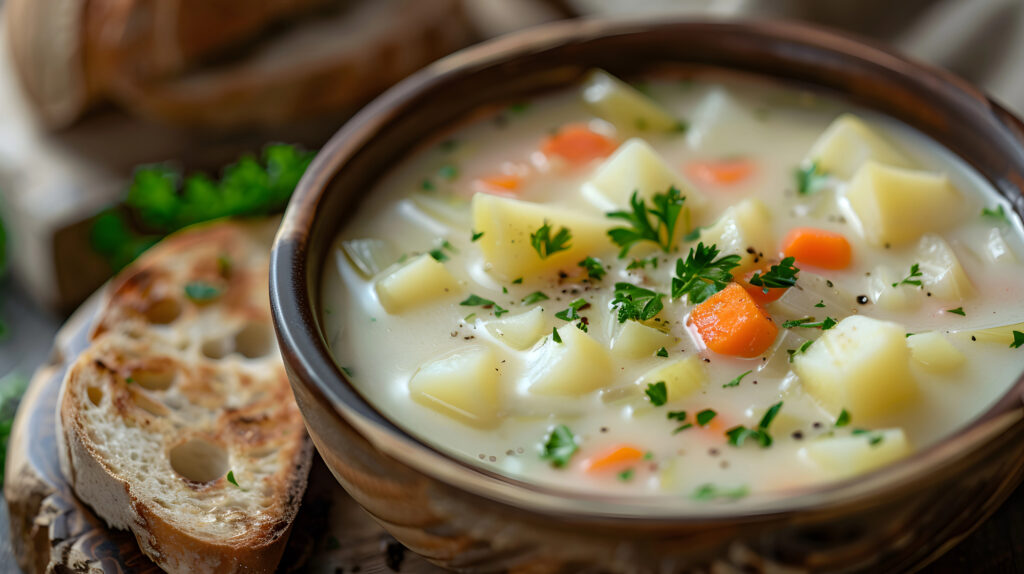
Dietary Adaptations
Modify this dairy-free potato soup to accommodate various dietary needs:
Gluten-Free Version
I recommend replacing all-purpose flour with rice flour, cornstarch, or arrowroot powder in your thickening roux. Be vigilant about your vegetable broth and all seasonings, ensuring they’re certified gluten-free as many commercial products contain hidden gluten. For extra body, consider adding 1/4 cup of cooked, blended white rice as an additional thickener—this creates a silky consistency while maintaining the soup’s gluten-free integrity.
Low-Sodium Adaptation
Create a heart-healthy version by using salt-free vegetable broth or making your own without added sodium. Instead of relying on salt, I enhance flavor depth with bright acids like lemon juice and abundant fresh herbs. Further reduce sodium content by using fresh potatoes rather than any canned products which often contain added salt. For a savory dimension without excessive sodium, incorporate a tablespoon of white miso paste, which provides complex umami notes while using significantly less sodium than salt.
Reduced-Carb Option
Achieve a lighter carbohydrate profile by replacing half the potatoes with cauliflower or celeriac, which provide a similar texture with fewer carbs. Incorporate fiber-rich vegetables like zucchini for added volume and nutrition without significant carbohydrate content. I create creaminess with puréed white beans, which add protein while contributing to the soup’s satisfying texture. Enhance flavor with nutritional yeast, which provides a cheese-like taste without carbs. Include modest amounts of whole grains like barley for sustained energy and textural contrast, adding fiber that helps moderate blood sugar response.
High-Protein Modification
Transform this soup into a protein powerhouse by adding white beans, chickpeas, or lentils—approximately 1/2 cup cooked legumes per serving provides substantial protein. Before serving, stir in 2-3 tablespoons of hemp seeds, which are rich in complete protein and healthy omega fats. Choose soy milk as your plant-based milk base instead of other alternatives, as it contains significantly more protein. I complete the protein-rich profile with a generous garnish of nutritional yeast or plant-based protein crumbles, creating a soup that satisfies hunger longer and supports muscle maintenance.
Store-Bought Dairy-Free Potato Soup Options
For those days when you’re short on time or looking for a convenient option, Imagine Organic Creamy Potato Leek Soup is a great store-bought choice. This USDA-certified organic soup is made with high-quality, non-GMO ingredients and is gluten-free, vegan, and kosher. While homemade dairy-free potato soup is always a treat, having a few ready-to-serve options on hand can be a lifesaver on busy days.
- 32 oz. carton of Imagine Organic Creamy Potato Leek Soup
- Made with organic potatoes, sautéed leeks and roasted garlic
- Dairy and Gluten-free
- Certified Kosher and vegan
- Non-GMO Project Verified and USDA-Certified Organic
Seasonal Adaptations
Adapt your dairy-free potato soup to showcase the best produce each season offers:
Spring Variation
Incorporate fresh spring peas, asparagus tips, and tender herbs like chives and dill. Lighten the soup with a touch of lemon zest and a handful of fresh spinach stirred in at the end.
Summer Version
Add corn cut fresh from the cob, diced zucchini, and fresh basil. Consider serving this variation chilled as a refreshing vichyssoise-style soup with a drizzle of good olive oil.
Fall Adaptation
Introduce diced butternut squash or pumpkin alongside the potatoes, and enhance with warming spices like nutmeg and cinnamon. Garnish with toasted pumpkin seeds and fried sage leaves.
Winter Comfort Bowl
Incorporate hearty root vegetables like parsnips and turnips with the potatoes. Add rosemary, thyme, and a bay leaf for depth. Finish with a drizzle of truffle-infused olive oil for special occasions.

Storing and Reheating
Ensuring freshness and preserving flavor during storage and reheating is essential.
Best Practices for Storage
For optimal freshness:
- Cool the soup completely before refrigerating (within two hours of cooking)
- Store in airtight containers to prevent contamination and odor absorption
- Refrigerate for up to 3-4 days
- For longer storage, freeze for 2-3 months in freezer-safe containers
- Leave one inch of headspace in containers to allow for expansion during freezing
- Label containers with the date of storage
- Consider portioning into single servings before freezing for convenient reheating
Reheat Without Sacrificing Quality
To maintain the soup’s creamy texture:
Stovetop Method:
- Thaw frozen soup in the refrigerator overnight
- Reheat gently over medium-low heat, stirring occasionally
- Add a splash of plant-based milk if the soup has thickened too much
- Heat until the internal temperature reaches 165°F
- Avoid boiling, which can affect texture and flavor
Microwave Method:
- Transfer soup to a microwave-safe container
- Cover with a vented lid or microwave-safe wrap
- Heat in one-minute increments, stirring between each
- Add additional liquid if needed
- Ensure even heating throughout
For both methods, always taste and adjust seasonings after reheating, as flavors can change during storage—a fresh squeeze of lemon juice or sprinkle of herbs can revitalize the soup’s taste profile:
The Dairy-Free Advantage
Dairy-free potato soup combines tradition with innovation, proving that creaminess and flavor don’t require dairy products. The natural starchiness of potatoes—particularly Russets and Yukon Golds—creates a naturally creamy consistency when properly prepared.
The key to exceptional dairy-free soup lies in thoughtful substitutions. Select the right plant-based milk for your desired outcome: coconut cream for richness, oat milk for silkiness, or cashew cream for buttery notes. Build flavor depth through aromatic vegetables, herbs, and strategic additions like nutritional yeast for a subtle cheesy quality.
Most importantly, dairy-free potato soup is inclusive. It accommodates diverse dietary needs while remaining delicious. Whether serving someone with lactose intolerance, following a vegan lifestyle, or managing multiple food sensitivities, this adaptable dish brings everyone together to enjoy the universal comfort of a warm, satisfying bowl of soup—not just “good for being dairy-free” but genuinely excellent in its own right.
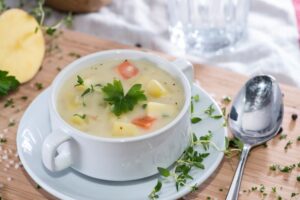
*We may earn a commission for purchases made using our links. Please see our disclosure to learn more.

